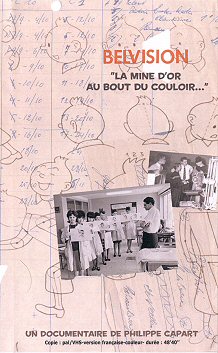Belvision: la mine d'or au bout du couloir …

- Image © Auxin, CBA, Michel de Wouters Productions.
- Belvision: la mine d'or au bout du couloir …
- By Philippe Capart assisted by Dino and Sirio Sechi.
- Sound recording: Studio Dame Blanche
- A co-production of Auxin, CBA, Michel de Wouters Productions.
- French language only
- Review:
This fascinating, well-researched documentary explores the history of the Belvision studios, and includes interviews with Raymond Leblanc, founder of the studios in 1954, American animator Larry Harmon, BD artists Albert Uderzo and Tibet as well as many surviving Belvision personnel. The documentary opens with a tantalizing glimpse of Claude Misonne’s work—a 1946 publicity film for Tintin magazine, using the puppet animation he employed for Le Crabe aux Pinces d'Or.
Archive clips show behind-the scenes footage from the studio and the development of techniques throughout the years, beginning with the primitive camera zooms and pans of Willy Wandersteen’s Bob et Bobette, through to the simple, moving cut-outs of the Tintin adventures L'Oreille Cassée and Le Sceptre d’Ottokar in the late 50s. The early Tintin films were made with the help of the RTF (the national French television) and Anne-Marie Ullmann, an employee who worked with the team, is interviewed.
Yvan Szücs joined as director/executive producer in 1959, improving the craft further with Hergé’s On a Marché sur la Lune (actually the Objectif Lune album) and Macherot’s Chlorophylle. The use of celluloid brought the studios into a new phase. In his interview Larry Harmon recounts his meeting with Hergé and draws comparisons between the first films done by his studio with the earlier productions, remarking that “the American version was faster, sharper, had more of a speed to it, than the slower, more relaxed action and reaction that the European attitude towards animation had.” Harmon’s fast paced, dynamic style left it’s mark and the series continued with the Belgian, Ray Goosens as director/producer and the American, Charlie Shows – a Hanna-Barbera scriptwriter and cartoonist – hired by Leblanc to do the storyboards. Hergé attached Michel Greg to the team in order to supervise the quality and respect to the spirit of Tintin.
Ray Goosens was to lead Belvision into a new era and the next major project, the charming, yet downright strange, Pinocchio in Outer Space feature film shows how far the studios had come. In this “sequel” to the Disney adventure, completed in 1964, the Blue Fairy turns Pinocchio back into a wooden puppet for misbehaving. In order to prove himself and regain his boyhood he heads into space, meets Nurtle the turtle, lands on Mars and comes up against Astro, the flying Martian whale. It was co-produced with Americans Fred Ladd and Norman Prescott who are both interviewed and recall how the project went over budget. By the mid-60s Belvision were leading the field in Europe. Snippets from Spaghetti a la Romaine, Coin-coin and Goscinny and Uderzo’s Oumpah-pah show how the studios had achieved a technical know-how comparable only to the American animations being made at the time. A film test for Hanna-Barbera’s The Flintstones from 1965 (known as Les Pierre-à-feu in French) is also revealed.
Uderzo is interviewed and tells of his initial disappointment with the first Asterix animations and how he went on to help supervise the storyboards for Asterix et Cleopatre in 1968. Belvision also produced two more Tintin cinema films, Le Temple du Soleil in ’69 and Tintin et le Lac aux Requins in 72. Facing financial difficulties, the studio began to go into demise in the late 70s and had to abandon its production of feature animation, devoting itself instead to making commercials and animations for science documentaries.
Text © 2004 Chris Owens.
